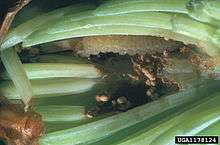Zeiraphera canadensis
| Zeiraphera canadensis | |
|---|---|
 | |
| Scientific classification | |
| Kingdom: | Animalia |
| Phylum: | Arthropoda |
| Class: | Insecta |
| Order: | Lepidoptera |
| Family: | Tortricidae |
| Genus: | Zeiraphera |
| Species: | Z. canadensis |
| Binomial name | |
| Zeiraphera canadensis Mutuura & Freeman, 1967 | |
Zeiraphera canadensis, the spruce bud moth, is a moth of the Tortricidae family.
The larvae feed mainly on Picea glauca but they have been found on other species of spruce and fir.[1] While it is not a concern in natural stands, in spruce plantations it is considered a pest, as repeated years of defoliation lead to deformity in the crown, loss of stem form and lower productivity.[2]
Distribution
Mainly in eastern North America, but it is found across the continent.[1]
The spruce bud moths of the genus Zeiraphera, transcontinental in range, are found frequently on white spruce but only occasionally on other spruces and firs (Rose and Lindquist 1985).[3] Zeiraphera canadensis (Mutuura and Freeman Lepidoptera: Tortricidae), has caused a high incidence of multiple and abnormal leaders in white spruce in the Maritime provinces, Quebec, and Maine (Quiring et al. 1991).[4] However, although severe feeding damage has seldom been extensive in forests, new shoots on open-grown white spruce are frequently disfigured (Rose and Lindquist 1985).[3] The insect overwinters in the egg stage on the tree. The larva emerges in May and feeds underneath the bud cap, which it characteristically secures to the growing shoot with silk. The cap remains in place long after the other bud caps have been shed, an obvious impediment to the effectiveness of contact insecticides. When populations are high, it is not unusual to find several larvae feeding among the needles of a single shoot. The head and thoracic legs of young larvae are dark brown, but full-grown larvae are cream to yellow and about 10 mm long. Feeding is completed in June or early July, whereupon the larva drops to the ground and becomes a pupa in the litter. From mid-July to mid-August, moths emerge from the pupae to lay eggs singly or in groups of two to seven at the base of shoots of the current year. In a New Brunswick seed orchard, white spruce of intermediate height (1.5 to 3.73 m) were damaged most, and damage in one year was positively correlated with damage in the next. At four test sites, mean growth reduction of trees in the two most susceptible families was estimated to be approximately 30% higher than those of trees in the two least susceptible families. The lack of damage to some trees, among those trees suffering damage, suggested the existence of genetically based differences in susceptibility to this pest.
Life cycle
Z. canadensis overwinters as an egg on the tree, emerging in May it feeds on developing bud, eating new needles and the developing bark of the shoot.[1] A characteristic indicator of this feeding is observing the bud cap remaining at the tip of the branch long after the rest have fallen off.[1] The budmoth secures the bud cap to the developing cap with silk, enabling it to feed securely underneath.[1] Once feeding is complete in June/early July, the larvae drops to the soil and pupates in the leaf litter, emerging in July/mid-August, where they lay their eggs.[1]
The mature larvae is 10 mm long and creamy yellow.[1]
References
- 1 2 3 4 5 6 7 Rose, AH and Lindquist, OH, "Insects of Eastern Spruces, Fir and Hemlock". Department of the Environment, Canadian Forestry Service, 1977, p. 31.
- ↑ Carrow, JR, "Spruce Bud Moth - A Case History: Opportunities". The Forestry Chronicle, 1985, p247
- 1 2 Rose, A.H.; Lindquist, O.H. 1985. Insects of eastern spruces, fir and, hemlock, revised edition. Gov’t Can., Can. For. Serv., Ottawa, For. Tech. Rep. 23. 159 p. (cited in Coates et al. 1994, cited orig ed 1977)
- ↑ Quiring, D.; Turgeon, J.; Simpson, D.; Smith, A. 1991. Genetically based differences in susceptibility of white spruce to the spruce bud moth. Can. J. For. Res. 21(1):42–47.